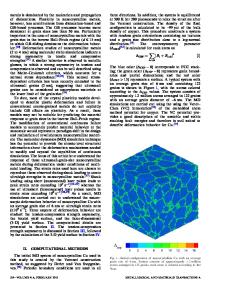Atomic Scale Characterisation of Electrodeposited Nanocrystalline Ni-P Alloys
- PDF / 1,150,522 Bytes
- 6 Pages / 417.6 x 639 pts Page_size
- 14 Downloads / 329 Views
NANOCRYSTALLINE Ni-P ALLOYS Matthias Abraham, Mattias Thuvandert, Helen M. Lane, Alfred Cerezo, George D.W. Smith Dept. of Materials, Oxford Univ., Oxford OXI 3PH, U.K., [email protected] , present address: Volvo Technological Development Corporation, Dept 06420 Z1.1, SE-405 08 Goteborg, Sweden ABSTRACT
Nanocrystalline Ni-P alloys produced by electrodeposition have been characterised by threedimensional atom probe (3DAP) analysis. In the as-deposited materials, there are indications of some variation in P concentration between grains and segregation to grain boundaries. After heat treatment however, strong grain boundary segregation and the formation of Ni 3 P precipitates have been observed. INTRODUCTION
The thermal stability of nanocrystalline materials is a very important issue. Due to the large driving force for grain growth, provided by the considerable volume fraction of high energy grain boundaries, pure nanocrystalline materials can be unstable even at moderate temperatures. By introducing certain elements such as P into the materials, their thermal stability can be greatly improved. In order to understand the mechanism by which these elements affect the thermal stability of nanocrystals, and to predict the long-term behaviour of these materials, characterisation methods at the atomic scale are required. In this paper, the three-dimensional atom probe (3DAP) analysis [1, 2] has been used to investigate the grain boundary chemistry within nanocrystalline Ni-P produced by electrodeposition
[3]. EXPERIMENT
Electrodeposition is a well established method for the production of bulk nanocrystalline materials of low porosity and high purity [4, 5]. In this work nanocrystalline Ni-P alloys were produced from a nickel sulphate based bath with additions of phosphoric acid and phosphorous acid. The plating was performed at a constant current density of typically 6.6 A dm-2. The materials were deposited as discs of about 0.3 mm thickness and 22 mm diameter onto either copper or stainless steel sheets, from where they could be peeled off easily. The P concentration could be controlled over a wide range by changing the concentration of phosphorous acid in the plating solution. One surprising observation to be noted here is that saccharin which is often used as a grain refining additive in electrodeposition of pure Ni was found to inhibit the deposition of P and was therefore not used subsequently. To perform 3DAP analysis, specimens in the form of a sharp needle with tip radius below 100nm have to be produced. Conventional electropolishing methods can be applied for this purpose. The principle of the 3DAP is sketched schematically in Fig. 1.The specimen is brought into a UHV system and subjected to a positive voltage of a few kV. The voltage is high enough to cause field evaporation of individual atoms at the tip where the electric field is strongest. To control the time of evaporation, a short pulse is added to the voltage such that evaporation only occurs during the pulse. The ions, leaving the tip
Data Loading...










